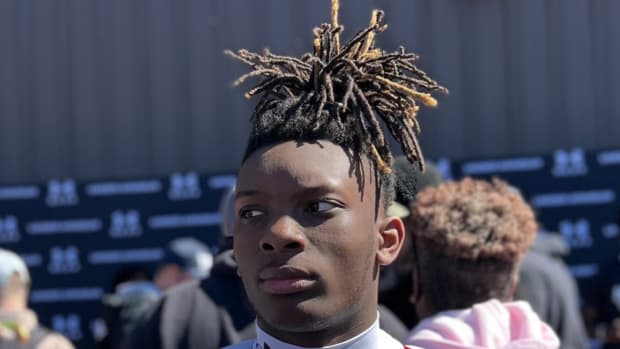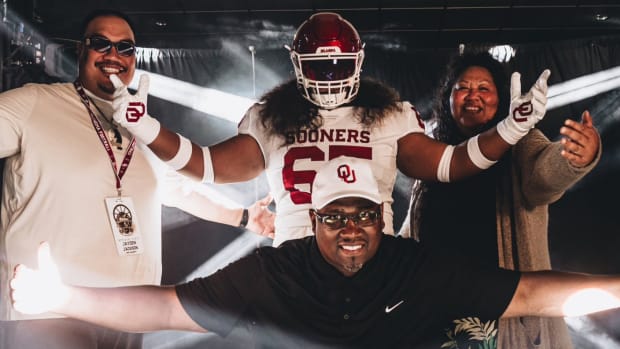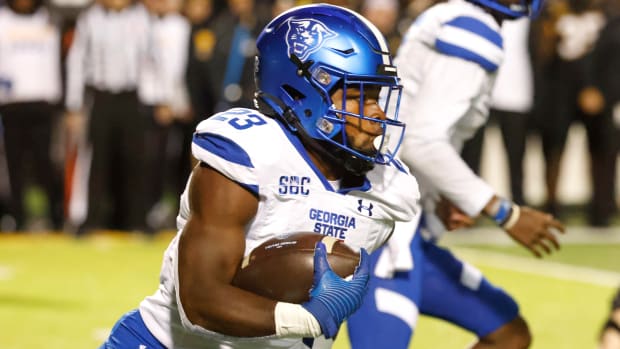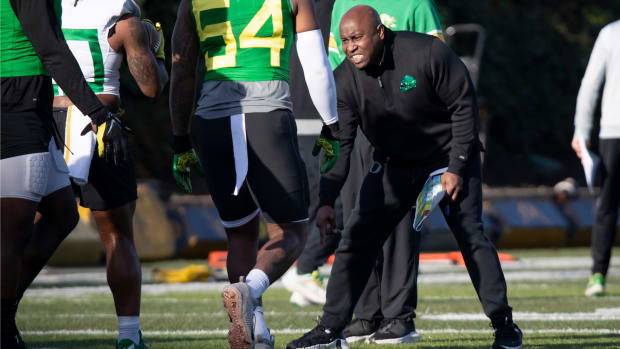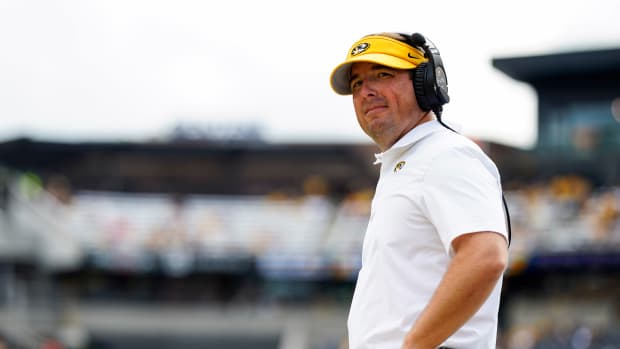Alabama and Georgia Are Destined to Be the SEC's Next Defining Rivalry
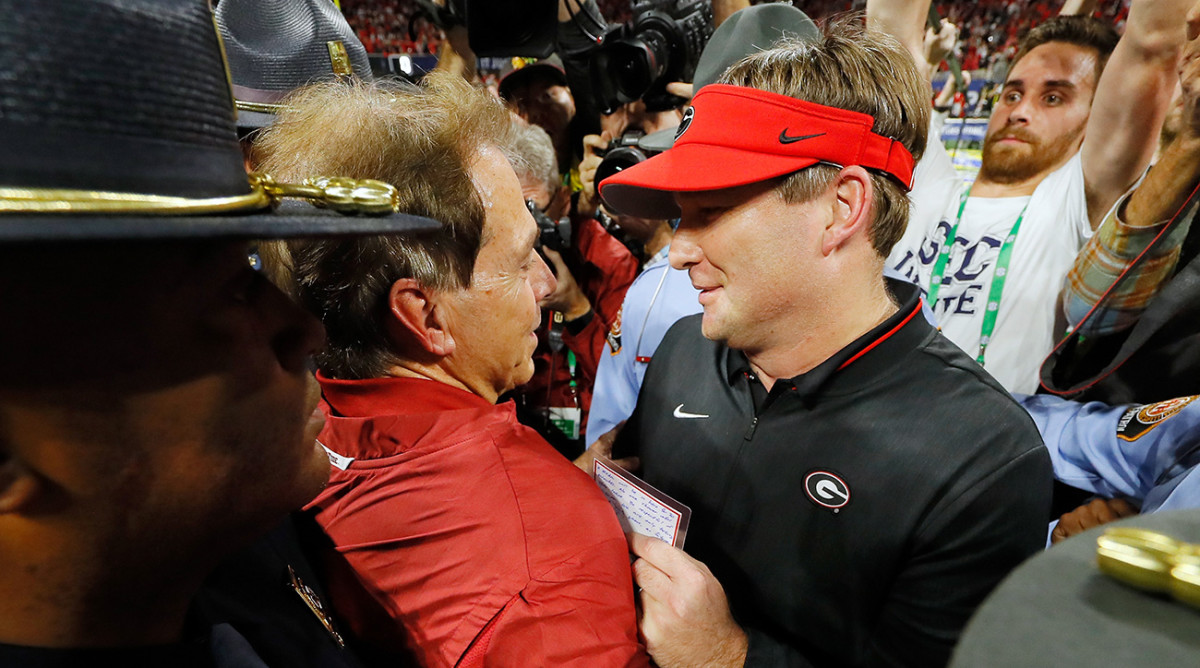
DESTIN, Fla. — Throughout this spring meeting season, the easiest way to get a millionaire football coach on his soapbox was to bring up the NCAA’s transfer portal. Most coaches are freaked out by the notion that they can’t control where players are allowed to transfer on scholarship.
You have reached your limit of 4 premium articles
Register your email to get 1 more
At the SEC’s spring meetings on Tuesday, the waters were thoroughly chummed with transfer portal questions, but two coaches handled those questions differently than most of their colleagues around the country have. Alabama’s Nick Saban and Georgia’s Kirby Smart are playing a different game than most of their brethren, so it makes sense that their responses would diverge from the mainstream.
“I can’t tell you how many guys are in the portal,” Saban said. “We check it just to see if there’s anybody we would be interested in if we have a position of need.” Said Smart: “I don’t think there’s a major concern there. You’ve got 85 scholarships. You’ve got to work off your 85.”
Translation: Everyone wants to play for us. If someone leaves, it’s because they aren’t playing as much as they think they should. And if we do have an open spot, we know there are dozens of good players who would crawl across broken glass to get on our rosters. Clemson’s Dabo Swinney, Oklahoma’s Lincoln Riley and Ohio State’s Ryan Day can take similar stances because their programs are in similar places. Unlike many of their counterparts, they don’t consider the introduction of the portal—which remains the coolest name ever for an online spreadsheet—to be the start of the downfall of western civilization. Where their less accomplished, less creative counterparts see chaos, they see opportunity.
That there are two SEC programs acting this way instead of one should excite everyone within the league. Since splitting into divisions in 1992, the SEC has always been the most fun when two programs duked it out at the top. For much of the first decade after the split, those two programs were Florida and Tennessee. That was a little anticlimactic because Florida won so many of those matchups and because those games always took place in September. The ideal came in 2008 and ’09 when Alabama and Florida played in consecutive SEC title games that served as de facto national semifinals. But then Urban Meyer quit, came back and quit again in Gainesville and Alabama essentially ruled the league—with guest appearances by Auburn and LSU—for most of this decade. That changed when Smart got to Athens. Saban won the SEC West in his second year at Alabama. Smart won the SEC in his second year at Georgia in 2017 but fell to Alabama in overtime of the national title game. Last year, the Bulldogs led the Crimson Tide for most of the SEC title game but fell when backup quarterback Jalen Hurts led Alabama back in the fourth quarter (shortly before Hurts entered the transfer portal and got beamed to Oklahoma).
Georgia is going to have to win one of these to turn this into a true slugfest at the top—and LSU, Auburn and Florida still may have their say—but it appears these two programs are set up for an epic rivalry. Saban may be 67, but he just had hip replacement surgery and got back to work. He claims he wants to work for a long time. Every coach who has to recruit players will always say he wants to coach at least five more years, but ask yourself this, what’s a retired Nick Saban going to do all day? He probably is on board for the foreseeable future. His former defensive coordinator Smart, meanwhile, has taken over Georgia’s scheduling and loaded up for the future with home-and-home series against Oklahoma, Clemson, Florida State and Texas. Smart, whose team has to play Georgia Tech every year, wants his team to play three Power 5 nonconference opponents a year, and Georgia is poised to do just that in the second half of the next decade. Smart claims the timing of that, which happens to almost coincide with the next College Football Playoff media rights deal, is not as prescient as we think.
“People have misstated that I believe that [the playoff] is going to go to this,” Smart said. “I have no clue what it’s going to. I am a company man along with the SEC that what we have works. So I’m not forecasting this. What I am forecasting is that we’re going to have a strength of schedule that’s going to allow us—whether we have one, two, four or eight teams—to be in the conversation because of who we play.” This also can be translated thusly: Smart plans to be Georgia’s coach for a long time, and he expects the Bulldogs to be in the national title conversation on an annual basis.
Alabama, which also has upcoming series signed with Texas, Notre Dame and West Virginia, likely will have to follow suit and load up. Saban acknowledged Tuesday that the draw of the neutral-site opener has diminished as fans have demanded more good games at home. It’s understandable that Saban would have a sentimental attachment to those games. After all, it was a 2008 season-opening demolition of Clemson in Atlanta that announced to the college football world that Alabama would be a force to be reckoned with for the foreseeable future. It also probably isn’t lost on Saban that this particular win hastened the departure of Tommy Bowden at Clemson. That brought about the Dabo Swinney era, which produced the current best program in college football. And now Alabama and Georgia may be squaring off in the next few Decembers for the opportunity to take their shot at Swinney’s Tigers.
The rest of the programs in the SEC don’t want that, and they’ll do their best to prevent it. Auburn, Florida, LSU and the rest will devote considerable resources to trying to head off an Alabama-Georgia rivalry that dominates this next era of SEC football and provides more games as entertaining as the last two times these teams have met. But those other SEC schools may not be able to stop something that feels inevitable as long as Saban and Smart keep playing a different game than everyone else.
A Random Ranking
This week’s topic comes courtesy of an argument between CBSSports.com NFL writer Will Brinson and his wife. They spent part of Monday evening trying to determine the best Steve Winwood song. As you’ll see, they’re both wrong. But we will follow the rules of the Brinson household as we choose the top five Winwood tunes. Only solo Winwood. No Spencer Davis Group. (Otherwise “Gimme Some Lovin’” is an easy No. 1.) No Traffic. No Eric Clapton collaborations. Get your synthesizer ready…
1. “Valerie” (the 1987 version)
2. “Higher Love”
3. “While You See A Chance”
4. “The Finer Things”
5. “Back In the High Life Again”
Three And Out
1. If it wasn’t already abundantly clear that the NCAA’s decision to establish a working group to determine how athletes might be able to make money off their name, image and likeness rights was motivated by potential legislative action, that point got driven home further when a bill was introduced in California last week that would force schools in the state to allow athletes to make money off their NIL rights. There also is a bill—sponsored by members of both major parties—in the Ways and Means Committee of the U.S. House of Representatives that, if passed, would strip the NCAA of its tax-exempt status if it doesn’t repeal its rule banning athletes from making money off their names.
The schools will have to work faster than usual to get ahead of this. While the bill in the U.S. House may not come up for a vote anytime soon, the California bill stands a good chance of passing. And California isn’t likely to be the only state to consider such a law. Politicians have figured out that in these divided times, one of the few things everyone can agree upon is a distaste for the NCAA. So the schools will have to come up with something that relieves the legislative pressure.
2. SI’s Ross Dellenger examined the discussion SEC leaders will have this week about the league’s out-of-date and out-of-touch alcohol sales policy. Basically, the hope within most athletic departments is that school presidents will come to their senses and lift the leaguewide ban on alcohol sales. That way, schools that want to sell alcohol at sporting events—cough cough LSU cough cough—will be able to set their own policies.
There are a few reasons this needs to happen. First, withholding something paying customers clearly want isn’t helping attendance issues. Second, it’s better for everyone if the guy currently using his smuggled-in flask to create jumbo Jack-and-Cokes chooses instead to buy a couple of $11 Bud Lights.
Keep reading down to What’s Andy Eating Drinking for a suggestion of a beverage to serve during September games.
3. In Division III news, St. Thomas—a private school in St. Paul, Minn.—has been thrown out of the Minnesota Intercollegiate Athletic Conference for being too good.
What’s Eating Andy?
Rest in peace, Rod and Paula Bramblett. The Auburn play-by-play announcer and his wife died from injuries sustained in a car crash on Saturday night.
In 2016, I had the pleasure of interviewing Rod about life as the voice of an SEC program. He told a great story about how his life changed after his iconic call of the Kick Six in 2013. Even though he may be gone, his voice will live on forever.
What’s Andy Eating Drinking?
Some of you considered last week’s discussion of bourbon barrel-aged beers to be a tad too snobbish for an eating-and-drinking section that typically has a populist bent. After all, I didn’t rip Guy Fieri’s Times Square restaurant. I ripped the guy from the New York Times who ripped Fieri’s Times Square restaurant. (Mostly because I get annoyed when someone plucks a fruit hanging so low that it’s almost touching the ground.) But I did feel pretty bougie touting beers that cost $4.50 a bottle at the liquor store and more than twice that at the bar. So I asked the people if I should review the most controversial macrobrew offering of the past few years. The people were emphatic.
For the uninitiated—which included me until a few weeks ago—Naturdays is strawberry lemonade Natural Light. That’s the elevator pitch, and it sounds utterly disgusting. Natty Light is the alcohol-flavored water we drank in college for one of two reasons:
• It was all we could afford.
• It was there.
Now the brewers of Natty have decided to make a pink lemonade version. Needless to say, I wasn’t optimistic when I plunked down $10.88 for an 18-pack at my local supermarket. (This was the smallest quantity I could find. Related: They make a 77-pack.) I had some pool days coming up. I figured that if anything could make this concoction tolerable, it would be a combination of 97-degree heat and chlorinated water.
So on Sunday I rolled my cooler out to the pool. I pulled out one of those flamingo-festooned cans and slid it into a coozie. I pulled the tab. I didn’t hold my nose as I brought the can to my lips, but I seriously considered it. The metal touched my tongue. The first few drops hit.
And…
It was delightful. It was cold, slightly sweet—but not too sweet—slightly tart and completely refreshing. Perhaps because Natural Light doesn’t really taste like beer, Naturdays doesn’t taste like beer masquerading as pink lemonade. It tastes like an entity entirely separate from the Natty Light universe we built when we were broke. At 4.2% alcohol by volume, Naturdays might be the perfect pool beer.
I know some of you out there are shaking your heads. You refuse to believe this. You may be muttering something about my man card. (It has been my experience that men who feel the need to reference a mythical Y-chromosome ID tend to be the least secure and the most pathetic, so mutter at your own risk.) Just taste it. I was sure I would hate this stuff.
Instead, the rest of that 18-pack is in the fridge waiting for the next pool or beach day. And when it’s gone, it may be time to grab that 77-pack.


